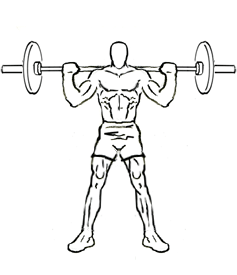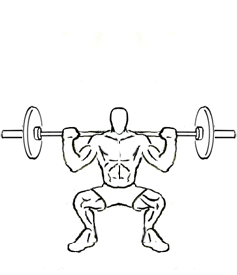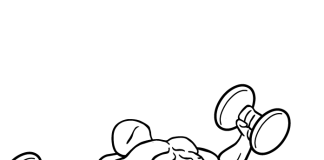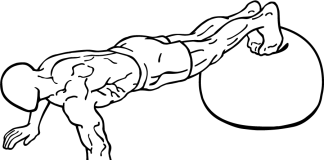Last Updated on September 25, 2014
The Wide Stance Squat with Barbell, often called a “Sumo Squat” due to its resemblance to the wide-footed stance of a sumo wrestler, is a powerful exercise that emphasizes the inner thighs (adductors) while also engaging the glutes, quads, and core. This squat variation allows you to target muscles that standard squats often overlook, creating a more balanced lower body workout and promoting stability and power.
In this comprehensive guide, you’ll learn how to perform the Wide Stance Squat with proper technique, the benefits it offers, common mistakes to avoid, tips for improving your results, and variations to try as you progress.
1. Exercise Overview: What is the Wide Stance Squat with Barbell?
The Wide Stance Squat with Barbell is a variation of the traditional squat. It involves placing your feet in a wider stance than shoulder-width apart, which increases the activation of the inner thighs and glutes. By widening your stance and pointing your toes slightly outward, you recruit the adductor muscles of the inner thigh, which are essential for lateral movement, balance, and stabilization of the pelvis.
Using a barbell adds resistance to the movement, making it an effective way to build strength and muscle in the lower body. This squat variation is ideal for anyone looking to improve inner thigh strength, stability, and overall leg power.
2. Step-by-Step Guide to Performing the Wide Stance Squat with Barbell
Step 1: Setting Up with the Barbell
- Position a barbell at shoulder height on a squat rack.
- Step under the bar and rest it across your upper back (not your neck). Grasp the bar with a firm, comfortable grip, slightly wider than shoulder-width.
Step 2: Positioning Your Feet
- Step back from the rack and position your feet wider than shoulder-width apart, around 30 inches apart. Your toes should point slightly outward, which helps engage the inner thighs.
Step 3: Engaging Your Core
- Draw in your abs to brace your core, which will help you maintain stability and proper posture throughout the squat.
Step 4: Descending into the Squat
- Begin lowering yourself by bending at the knees and hips, as though you’re sitting back into a chair. Keep your chest up, head facing forward, and back straight.
- Lower yourself until your thighs are parallel to the floor or as far as you can comfortably go while maintaining control. Avoid letting your weight shift toward your toes, as this can cause imbalance and strain on the knees.
Step 5: Pause and Return to Starting Position
- Pause briefly at the bottom of the movement to feel the engagement in your inner thighs and glutes.
- Press through your heels to return to the starting position, keeping the movement controlled and steady.
3. Benefits of the Wide Stance Squat with Barbell
The Wide Stance Squat offers several unique benefits that make it a valuable addition to any workout routine:
- Targets the Inner Thighs: The wide stance activates the adductor muscles, which aren’t as heavily targeted in traditional squats. Strong adductors are essential for hip stability and functional movements, particularly lateral movements common in sports and daily activities.
- Engages the Glutes and Hamstrings: This squat variation also works the glutes and hamstrings, helping you develop a stronger posterior chain, which is crucial for power and stability.
- Improves Hip Mobility: By positioning your feet wide and pointing your toes outward, the Wide Stance Squat encourages hip mobility, which can improve your performance in other exercises and daily movements.
- Builds Core Stability: As with any squat, this movement requires core engagement to maintain balance and proper form. A strong core is essential for protecting your lower back and supporting functional movements.
- Allows for Heavier Loads: The wider stance often enables lifters to handle more weight, providing an opportunity to increase lower body strength and muscle development.
4. Common Mistakes to Avoid
To make the most out of the Wide Stance Squat with Barbell, avoid these common mistakes:
- Shifting Weight Toward the Toes: Allowing your weight to shift forward can lead to knee strain and imbalance. Keep your weight centered over your heels to maintain control and protect your knees.
- Rounding the Back: Keeping a straight back is essential for protecting the spine. Rounding the back increases the risk of lower back injury. Keep your chest up, head facing forward, and engage your core to maintain a neutral spine.
- Letting Knees Collapse Inward: If your knees start to collapse inward, it can strain your knees and reduce inner thigh activation. Focus on pushing your knees out and keeping them aligned with your toes throughout the movement.
- Going Too Low Too Soon: While deep squats can be beneficial, going too low without proper form or flexibility can increase injury risk. Lower yourself only as far as you can control, and gradually increase your range of motion as you build strength and flexibility.
- Using Too Much Weight: Starting with a heavy barbell can lead to form breakdown and increase the risk of strain. Begin with a lighter weight, focus on your form, and gradually increase the load as you gain confidence and strength.
5. Tips to Maximize Results
Here are some tips to help you get the most out of the Wide Stance Squat with Barbell:
- Use Proper Footwear: Wear shoes with a flat, stable sole for squats. Avoid running shoes or shoes with cushioning that can shift your balance.
- Practice with Bodyweight First: If you’re new to the wide stance squat, start with just your bodyweight or a lighter load to get comfortable with the movement before adding the barbell.
- Focus on Controlled Movement: Slow, controlled movements help keep tension on your muscles and reduce the risk of injury. Avoid bouncing or rushing through the squat.
- Incorporate Warm-Up Sets: Warm up your muscles and joints with dynamic stretches and lighter-weight squats to prepare your body for the heavier load.
- Engage Your Core Throughout: Draw your abs in and keep them tight to help protect your lower back and maintain stability as you squat.
6. Variations and Modifications
To keep your routine challenging and target different muscles, try these variations of the Wide Stance Squat with Barbell:
- Bodyweight Wide Stance Squat: For beginners, practicing the wide stance squat with just your bodyweight helps you focus on form and balance without the added weight.
- Dumbbell Wide Stance Squat: Hold a dumbbell with both hands at chest level instead of using a barbell. This variation is a great way to add weight while maintaining an upright posture.
- Smith Machine Wide Stance Squat: Using a Smith Machine can provide additional stability, making it easier to control the movement. This is a good option for those new to squats or recovering from injury.
- Goblet Wide Stance Squat: Hold a kettlebell or dumbbell in front of your chest as you squat. This variation promotes an upright torso and increases core engagement.
- Single-Leg Wide Stance Squat: For a more advanced challenge, try a wide stance squat with one leg raised on a bench or platform. This increases the load on one leg, helping to address any strength imbalances.
7. Integrating the Wide Stance Squat with Barbell into Your Workout Routine
Adding Wide Stance Squats to your routine can strengthen your lower body and improve inner thigh stability. Here’s how to incorporate them effectively:
- Reps and Sets Recommendations: For strength, aim for 3-4 sets of 6-8 reps with a challenging weight. For muscle endurance, perform 2-3 sets of 10-12 reps with a moderate weight.
- Best Pairings: Pair wide stance squats with other lower body exercises like lunges, deadlifts, or traditional squats. Combining these exercises provides a balanced workout for all leg muscles.
- Rest Intervals: Allow 60-90 seconds of rest between sets. This gives your muscles time to recover without reducing workout intensity.
8. How to Track Progress
Tracking your progress in the Wide Stance Squat with Barbell will help you stay motivated and ensure continuous improvement:
- Log Your Weight and Reps: Keep a workout journal or use an app to track the weight and reps for each session. Gradually increase the load as you build strength.
- Monitor Range of Motion: As you gain flexibility, aim to lower yourself a bit deeper in the squat while maintaining form. Improved depth is a sign of increased hip mobility and leg strength.
- Check for Balanced Strength: Ensure you’re developing balanced strength in both legs. If you notice one side is weaker, consider unilateral exercises to address any imbalances.
9. Frequently Asked Questions
Q: Can Wide Stance Squats replace regular squats in my routine? A: Wide stance squats are a great complement to regular squats but shouldn’t completely replace them. Each variation targets different muscle groups. Incorporating both can lead to balanced leg strength and development.
Q: Are Wide Stance Squats safe for people with knee issues? A: If you have knee issues, consult a medical professional before adding wide stance squats to your routine. Starting with a lighter weight and focusing on form can reduce strain on the knees, but it’s best to follow expert guidance.
Q: Should I perform Wide Stance Squats quickly or slowly? A: Perform the exercise slowly and with control. Quick movements can lead to momentum-based lifting, which reduces muscle activation and increases the risk of strain.
Conclusion
The Wide Stance Squat with Barbell is a highly effective exercise for targeting the inner thighs, glutes, and core. It’s an essential move for anyone looking to build a well-rounded lower body workout and improve stability, power, and flexibility. By widening your stance and focusing on controlled movements, you can strengthen muscles that are often neglected in standard squats.
Remember, proper form is essential to gain the full benefits of the Wide Stance Squat with Barbell. Follow the steps outlined in this guide, avoid common mistakes, and progress slowly with variations and increased weight. With consistent effort, you’ll see significant improvements in leg strength, balance, and overall power.
So, next leg day, grab a barbell, set your feet wide, and get ready to take your squat routine to the next level!








